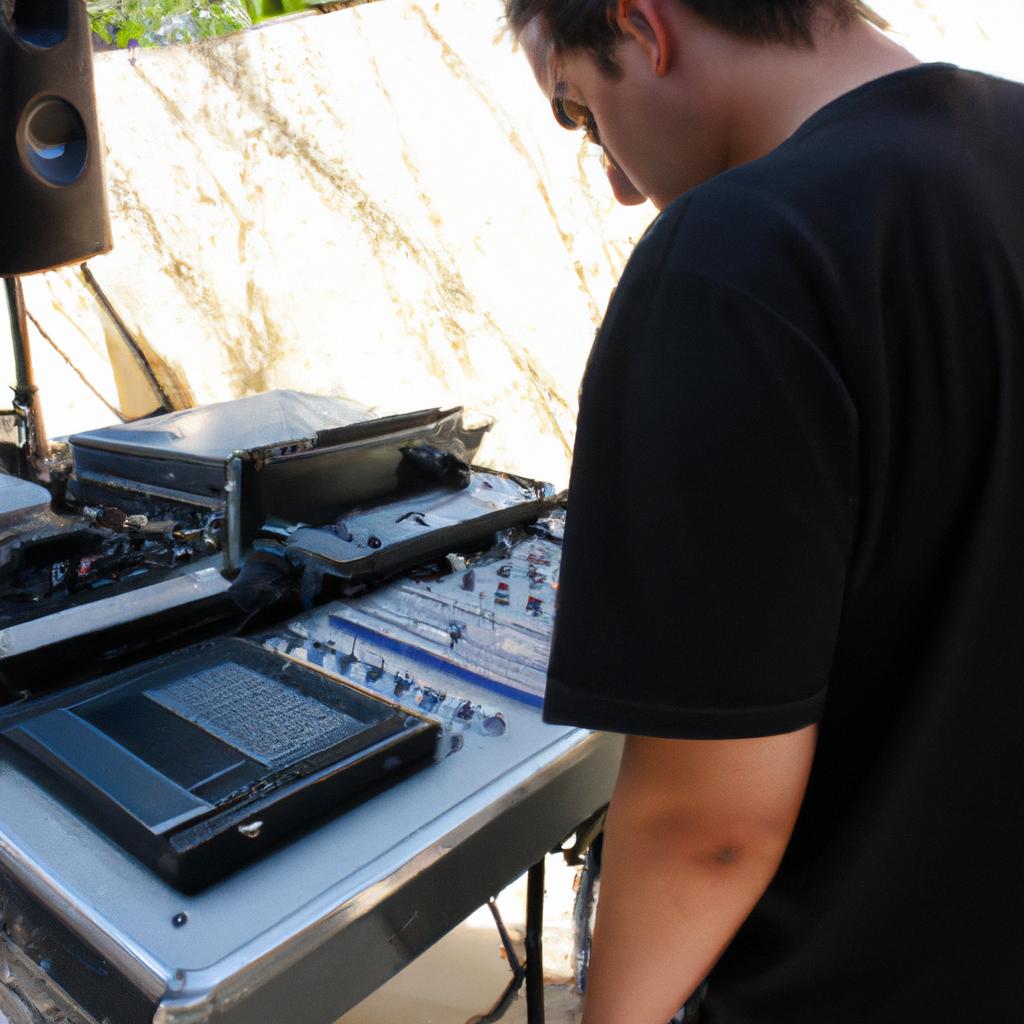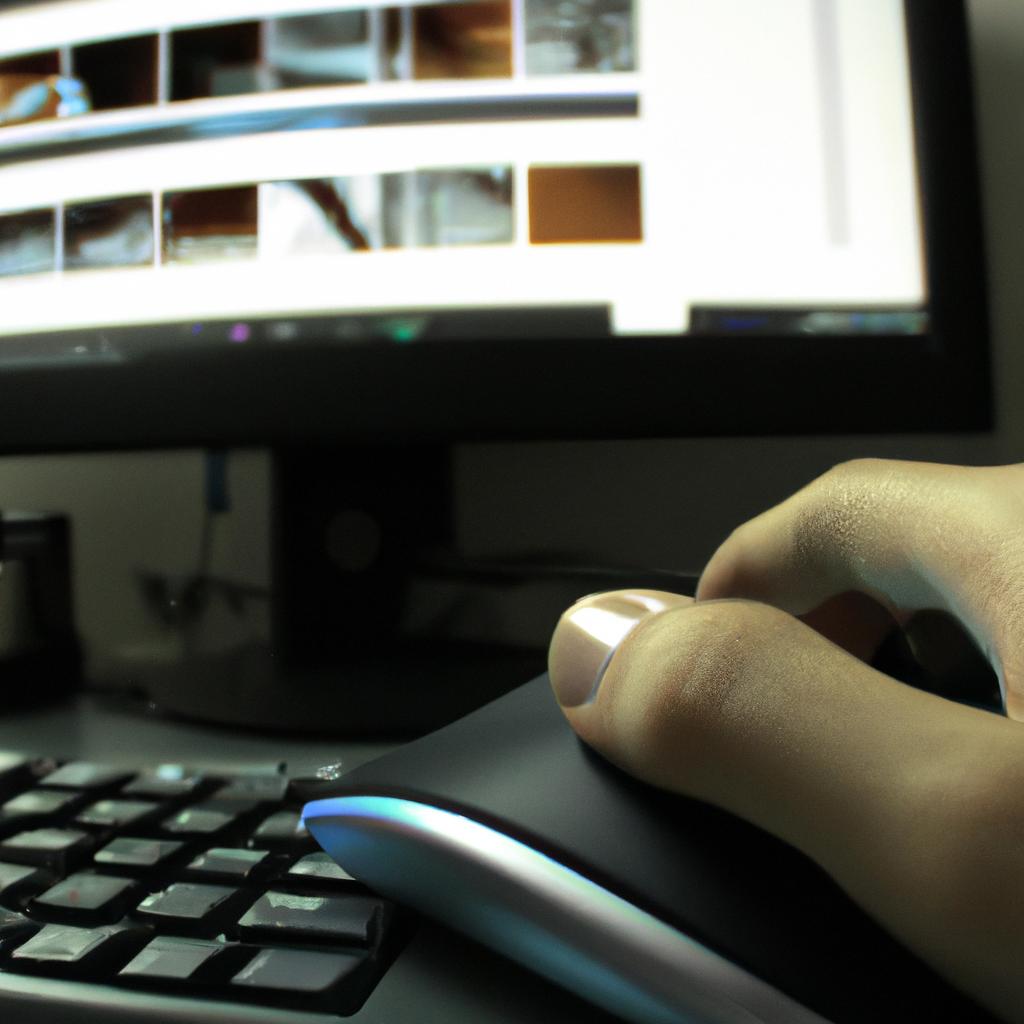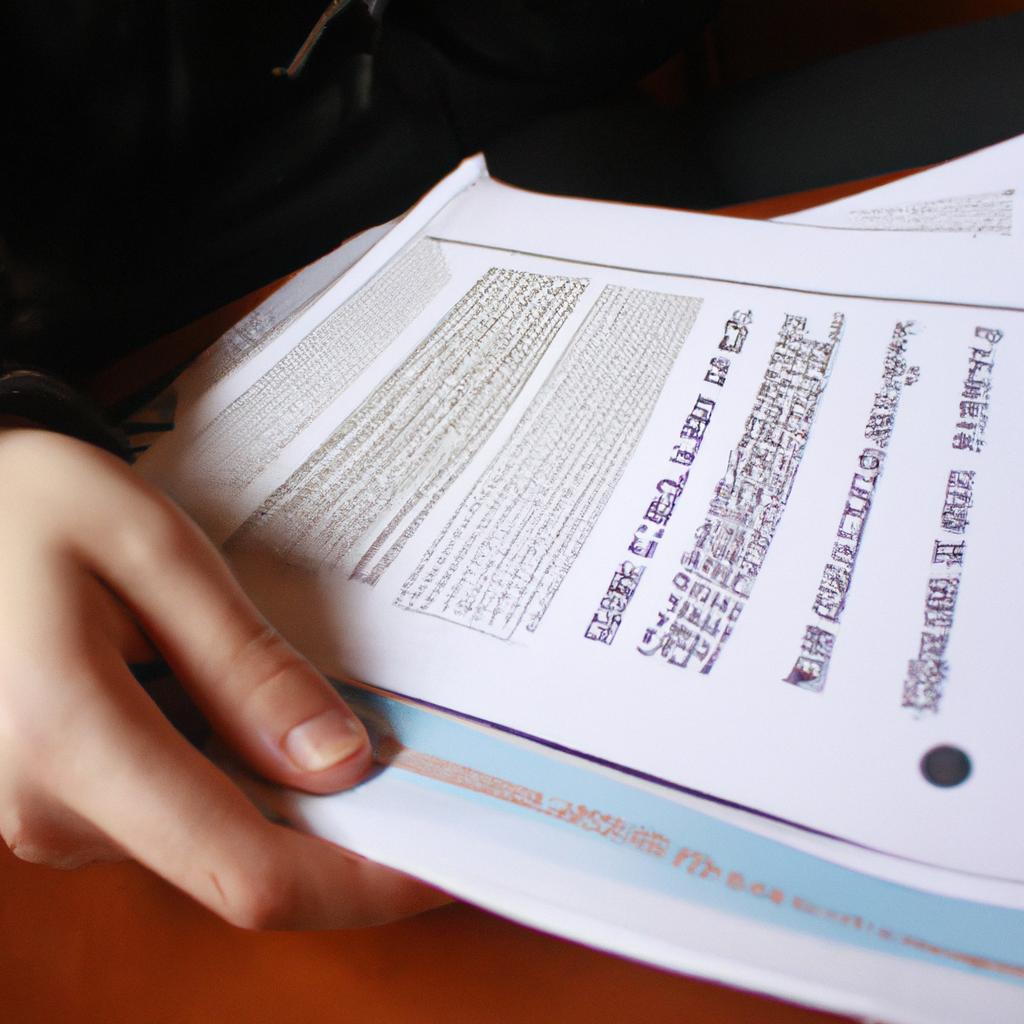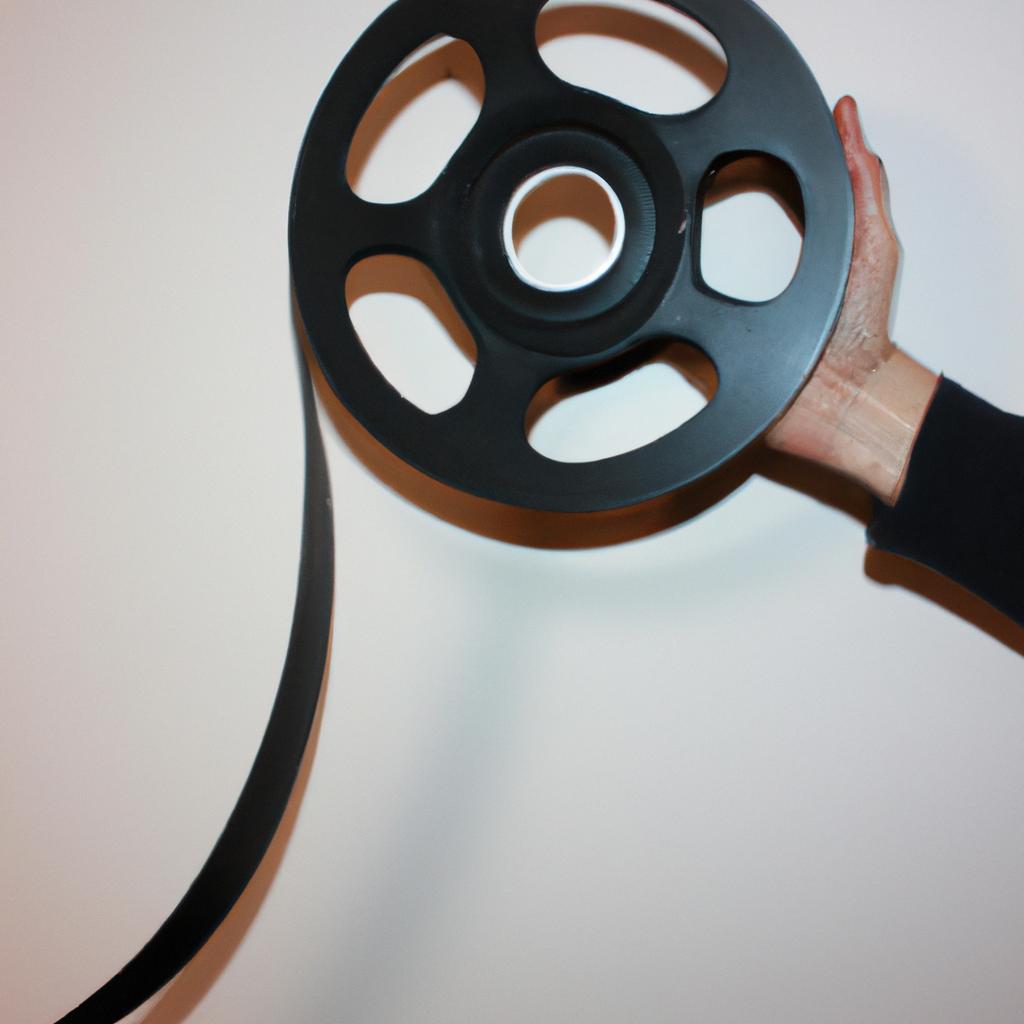Sound Design: Enhancing the Cinematic Experience in Arts and Entertainment

The art of sound design plays a vital role in enhancing the cinematic experience within arts and entertainment. Through meticulous planning, creative execution, and technical expertise, sound designers have the power to transport audiences into immersive worlds and evoke emotions that complement visual storytelling. For instance, consider the case study of the film “Inception” directed by Christopher Nolan. The masterful use of sound throughout the movie not only aided in creating suspense but also contributed significantly to building tension and heightening viewer engagement.
In recent years, there has been an increasing recognition of the importance of sound design as a significant component in filmmaking. This article explores how sound design influences audience perception, understanding, and emotional response in various forms of artistic expression. By examining real-world examples from films like “Jurassic Park,” where carefully crafted sound effects brought dinosaurs to life with lifelike realism or analyzing hypothetical scenarios showcasing innovative approaches to spatial audio technology, this article delves into the multifaceted nature of sound design’s impact on the overall cinematic experience.
Moreover, this article aims to shed light on the technical aspects behind successful sound design techniques employed by professionals across different mediums such as movies, video games, and live performances. Whether it be through Foley work – recreating sounds for everyday objects – or manipulating audio recordings to create unique and otherworldly effects, sound designers utilize a wide range of tools and techniques to achieve their desired sonic outcomes.
One notable aspect of sound design is the use of Foley work. Foley artists meticulously recreate everyday sounds in a studio setting, using various props and materials to mimic the sounds made by objects or characters on screen. This attention to detail allows for a heightened sense of realism and immersion, as audiences can hear footsteps, door creaks, or even the rustling of clothing that align with what they see visually.
Additionally, sound designers often employ innovative approaches to spatial audio technology. By strategically placing sounds within a three-dimensional space, they can enhance the sense of depth and directionality in a scene. This technique is especially impactful in action sequences or moments where characters are moving around the environment. It creates a more immersive experience for viewers by accurately representing how sound would behave in real life.
In video games, sound design serves not only as an immersive tool but also as a gameplay element. By utilizing specific audio cues, sound designers can provide critical information to players or indicate changes in the game’s environment or narrative. For example, the subtle shift in background music or the distinct sound associated with finding an item can alert players to important events or objectives.
Live performances also heavily rely on sound design to create memorable experiences for audiences. From concerts and theatrical productions to virtual reality experiences, expertly designed audio can transport viewers into new worlds or evoke powerful emotional responses. Sound designers collaborate closely with other creatives involved in these productions, ensuring that every auditory element complements and enhances the overall artistic vision.
Overall, sound design is an integral part of arts and entertainment that goes beyond simply providing background noise. Its careful orchestration has the power to shape narratives, evoke emotions, and transport audiences into different realities. By understanding its significance and appreciating its intricacies, we gain a deeper appreciation for all the ways sound design enhances our cinematic experiences.
The Importance of Sound Design in Immersion
Sound design plays a crucial role in enhancing the cinematic experience, immersing audiences into the world of film and entertainment. Through the strategic use of sound elements such as dialogue, music, and effects, filmmakers are able to transport viewers beyond the boundaries of their physical environment. By creating an auditory landscape that complements visual storytelling, sound designers have the power to evoke emotions and heighten audience engagement.
To illustrate this point, consider a suspenseful scene in a thriller film where a character is being chased through a dark alleyway. Without effective sound design, the impact of this scene would be significantly diminished. However, by incorporating subtle ambient sounds like echoing footsteps or distant sirens, along with tense musical cues and heightened breathing patterns for added intensity, the viewer becomes fully immersed in the heart-pounding chase sequence. This example highlights how skillfully crafted sound design can effectively manipulate our senses and enhance our emotional response.
In addition to intensifying emotions, sound design also has the ability to shape narrative structure and guide audience perception. A well-crafted soundtrack can subtly hint at upcoming plot twists or convey hidden meanings within a story. For instance:
- Through clever manipulation of audio levels and frequencies:
- Whispers can create an atmosphere of secrecy.
- Soft melodies can elicit feelings of nostalgia or melancholy.
- Jarring dissonance can generate tension or unease.
- Subtle background noises (e.g., clocks ticking) can foreshadow impending events.
By utilizing these techniques and more, sound designers contribute significantly to the overall effectiveness of storytelling on screen.
Creating Emotion and Atmosphere Through Sound follows seamlessly from this exploration of immersion through sophisticated sound design techniques. The next section will delve deeper into how specific audio choices influence audience responses and foster emotional connections between viewers and on-screen narratives
Creating Emotion and Atmosphere Through Sound
Section H2 Transition: Building upon the significance of sound design in creating immersion, it is equally important to explore how sound can evoke emotions and shape the atmosphere within a cinematic experience. By employing various techniques and elements, sound designers have the power to transport audiences into different emotional landscapes, enhancing their engagement with the visual storytelling.
One example that highlights the impact of sound on emotion and atmosphere is the film “Jaws” directed by Steven Spielberg. In this classic thriller, composer John Williams utilized specific musical motifs to elicit fear and tension among viewers. The iconic two-note theme played during suspenseful moments became instantly recognizable and synonymous with impending danger. This clever use of music not only elevated the sense of unease but also heightened audience anticipation throughout the film.
To further understand how sound design shapes emotions and atmospheres in cinema, we can examine several key techniques employed by professionals:
- Sound Effects: Skillfully chosen, meticulously crafted sound effects can intensify emotions by immersing viewers in a realistic auditory environment.
- Music Selection: Carefully selecting appropriate compositions or original scores enables filmmakers to enhance specific moods or create contrasting emotional states when needed.
- Ambience and Foley: Adding background noises like city traffic or footsteps through foley artistry brings authenticity to scenes while directly affecting viewer perception.
- Silence: Strategic silence can be just as impactful as any other element, providing contrast, emphasizing certain moments, or increasing tension through its absence.
These techniques work together harmoniously to craft an emotionally engaging experience for audiences. Consider the following table showcasing examples of how each technique contributes to evoking specific emotions:
| Technique | Example | Emotion Evoked |
|---|---|---|
| Sound Effects | Creaky door | Suspense |
| Music Selection | Uplifting orchestra piece | Elation |
| Ambience and Foley | Rainfall | Serenity |
| Silence | Absence of sound | Intensity |
In essence, the emotional impact of a film is heavily influenced by its sound design. By masterfully utilizing various techniques and elements, sound designers can manipulate emotions and create atmospheres that resonate with audiences on an intimate level.
Understanding how sound design enhances narrative and storytelling in cinema further expands our appreciation for the intricate relationship between audio and visual elements within this art form.
Enhancing Narrative and Storytelling
Transitioning from the previous section on creating emotion and atmosphere through sound, we now explore how sound design enhances narrative and storytelling in arts and entertainment. By strategically utilizing audio elements, filmmakers, game developers, and other creatives can engage audiences at a deeper level, immersing them within the story world. To illustrate this point, let us consider an example: imagine watching a suspenseful scene in a thriller film where the protagonist is searching for clues in a dimly lit basement. The eerie ambient soundscape combined with subtle creaks and distant footsteps heightens tension, conveying the character’s apprehension to the viewer.
Enhancing narrative and storytelling through sound involves several key aspects:
- Sound Effects: Sound designers meticulously choose or create specific effects that align with the narrative context. These effects can range from everyday noises like footsteps or doors closing to more abstract sounds that represent metaphorical concepts such as emotions or inner thoughts.
- Music Composition: Original scores composed specifically for films or games play a crucial role in setting the mood of each scene and guiding emotional responses. Elements like tempo, instrumentation, and melodic motifs help establish recurring themes tied to characters or events.
- Dialogue Placement: Effective dialogue placement ensures clarity while simultaneously contributing to character development and plot progression. Through careful mixing and editing techniques, conversations become intelligible even amid complex soundscapes.
- Foley Artistry: Foley artists add layers of realism by re-creating everyday sounds in sync with visual actions on-screen. From footsteps on different surfaces to handling props, these detailed sonic elements enhance immersion by grounding visuals with matching auditory cues.
To further understand the impact of sound design on storytelling, consider Table 1 below highlighting examples of how various audio components evoke emotional responses:
| Audio Component | Emotional Response |
|---|---|
| Subtle background music | Suspense |
| Loud explosions | Shock |
| Soft piano melody | Serenity |
| Eerie whispers | Fear |
In summary, sound design serves as a powerful tool for enhancing narrative and storytelling in arts and entertainment. Through careful selection of sound effects, music composition, dialogue placement, and foley artistry, creators can create an immersive experience that captivates audiences emotionally.
Sound Design Techniques and Principles
Building upon the importance of enhancing narrative and storytelling, sound design plays a pivotal role in creating an immersive cinematic experience. By employing various techniques and principles, sound designers have the ability to shape emotions, heighten tension, and bring a sense of realism to on-screen events. To illustrate this further, let’s consider the hypothetical example of a suspenseful thriller film.
One key technique utilized by sound designers is the manipulation of volume levels. By strategically adjusting the loudness or softness of certain sounds within a scene, they can create an auditory contrast that intensifies specific moments. For instance, imagine a scene where our protagonist hears faint footsteps approaching from behind while being pursued by an unknown assailant. Through meticulous control over audio dynamics, the sound designer could gradually increase the volume of these footsteps, amplifying feelings of unease and impending danger for both the character and audience.
In addition to volume manipulation, spatial positioning also greatly impacts how viewers perceive scenes. Utilizing surround sound technology or other advanced speaker systems, sound designers can place different elements in specific areas around the listener. This allows for a more realistic representation of on-screen action and enhances immersion. In our hypothetical thriller film example, imagine hearing whispers echoing through rear speakers as if coming from hidden corners of a dimly lit room. Such placement not only generates an unsettling atmosphere but also reinforces the feeling that something sinister lurks just out of sight.
To evoke emotional responses effectively through sound design, it is crucial for professionals to understand and employ key principles throughout their work:
- Contrast: Creating stark differences between quiet moments and intense sequences heightens emotional impact.
- Rhythm: Aligning sound with pacing helps establish tension or emphasize dramatic beats.
- Texture: Incorporating layers of diverse sounds adds depth to scenes, contributing to engagement.
- Timbre: Choosing appropriate sonic qualities ensures authenticity and resonance with audiences.
By skillfully applying these techniques and adhering to fundamental principles, sound designers have the ability to transport viewers into the world of a film and elicit powerful emotional responses.
With an understanding of sound design techniques and principles in place, let us now delve into the crucial aspect of collaboration between sound designers and filmmakers.
Collaboration Between Sound Designers and Filmmakers
Enhancing the Cinematic Experience: Collaboration Between Sound Designers and Filmmakers
Building upon the foundation of sound design techniques and principles, collaboration between sound designers and filmmakers is crucial in creating a truly immersive cinematic experience. By working closely together, they can effectively communicate their creative visions, identify sonic opportunities, and address potential challenges that arise throughout the production process.
To illustrate this collaborative relationship, let’s consider a hypothetical scenario where a filmmaker wants to create an intense chase scene set in a bustling cityscape. The sound designer understands the director’s vision and aims to enhance the tension by utilizing various sound elements. Together, they meticulously plan each aspect of the soundscape – from selecting appropriate ambient noises like car horns and sirens to crafting dynamic Foley effects for footsteps echoing through narrow alleyways.
This partnership allows both parties to harness their expertise and contribute unique perspectives towards achieving a cohesive artistic vision. Here are some key benefits resulting from effective collaboration between sound designers and filmmakers:
-
Enhanced storytelling: Sound design has the power to evoke emotions and immerse audiences further into the narrative. By collaborating closely, sound designers can help directors amplify certain moments or emphasize specific themes through carefully crafted auditory cues.
-
Seamless integration: Effective collaboration ensures that sound seamlessly integrates with other aspects of filmmaking such as cinematography, editing, and visual effects. This cohesion contributes to a more polished final product that captivates viewers on multiple sensory levels.
-
Creative problem-solving: Challenges often arise during film production, especially when it comes to capturing high-quality audio in challenging environments or dealing with unexpected technical issues. Collaborating allows both sides to brainstorm solutions together, leveraging their shared knowledge and expertise.
-
Pushing boundaries: When filmmakers collaborate with skilled sound designers who have a deep understanding of cutting-edge technologies and innovative techniques, they open doors to new possibilities for pushing artistic boundaries within the medium of film.
In summary, collaboration between sound designers and filmmakers is vital for creating a captivating cinematic experience. By working together closely and leveraging their respective expertise, they can enhance storytelling, seamlessly integrate sound into the overall production, creatively problem-solve, and push the boundaries of artistic expression.
Looking ahead to the future of sound design in arts and entertainment, advancements in technology will continue to shape this field’s landscape. From immersive spatial audio formats like Dolby Atmos to virtual reality experiences that rely heavily on realistic soundscapes, sound designers will play an increasingly pivotal role in pushing the boundaries of audience immersion.
The Future of Sound Design in Arts and Entertainment
Transitioning from the previous section on collaboration between sound designers and filmmakers, it becomes evident that the role of sound design extends beyond mere technical aspects. By harnessing their creative prowess, sound designers have the power to significantly enhance the cinematic experience for audiences. This section explores how sound design influences audience perception in arts and entertainment.
To illustrate the impact of sound design on audience perception, let’s consider a hypothetical case study involving a suspenseful thriller film. In this film, an intense chase sequence unfolds through dark alleys and abandoned buildings. Through meticulous sound design choices such as amplified footsteps echoing against concrete walls, distant sirens heightening tension, and haunting ambient sounds creating an eerie atmosphere, the audience is immersed into the heart-pounding action. These carefully crafted audio elements work together with visual cues to evoke fear, urgency, and anticipation among viewers.
Sound design has a profound influence on audience perception by engaging multiple senses simultaneously. Here are four key ways in which sound design can elicit emotional responses:
- Creating Atmosphere: The use of specific soundscape elements like background noises or environmental ambience can transport audiences to different settings and enhance their emotional connection to the narrative.
- Establishing Mood: Carefully chosen musical scores and sonic textures can effectively set the tone for each scene, evoking emotions ranging from joy and excitement to sadness or fear.
- Enhancing Narrative Focus: Well-crafted sound effects guide viewers’ attention towards crucial plot points by emphasizing significant actions or objects within a scene.
- Evoking Empathy: Subtle auditory details can humanize characters by providing insights into their inner world or conveying subtle emotions that might not be apparent through visuals alone.
In addition to these impactful techniques, another way in which sound design complements storytelling is through its ability to manipulate time and space. Considered one of cinema’s most potent tools – silence often serves as a powerful contrast to heightened sound moments. By skillfully using silence or strategically placed gaps in the audio, sound designers can create suspense, build tension, and amplify dramatic impact.
Through the deliberate integration of visual and auditory elements, filmmakers and sound designers collaborate to shape audience perception. The next section will delve into emerging technologies and innovative approaches that hold promise for the future of sound design in arts and entertainment.






